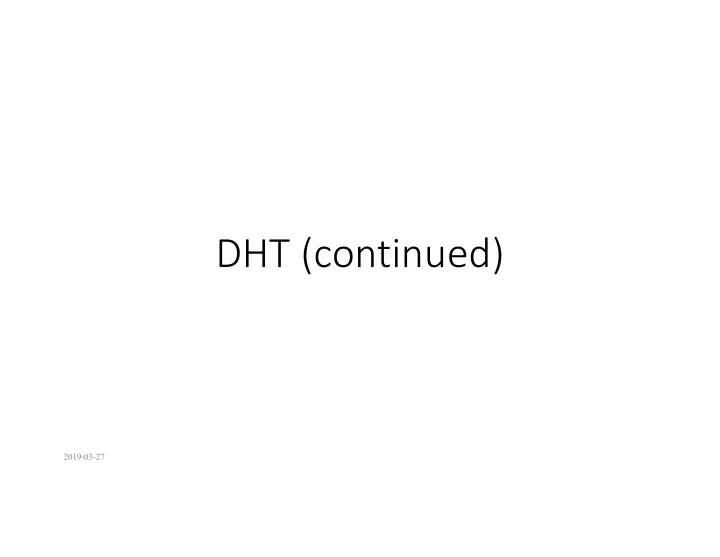

DHT (continued) 2019-03-27
Recap 0 N16 N112 • Nodes arranged in a ring with positions labeled 0..2 m -1 N96 • m = 128, 160, 256 m=7 • A node’s position is based on a hash of its N32 identity • P(collision among N nodes) =~ 1-e -n(n-1)/2^(m+1) • For m=128, N=1,000,000,000, this is ~= N45 N80 0.000000000000000000001469… 2019-03-27
Recap 0 N16 N112 • Nodes arranged in a ring with positions labeled 0..2 m -1 N96 • A node’s position is based on a hash of m=7 its identity N32 • A key x is stored at node with first position greater than x on the ring • Each node stores approximately 1/N of all N45 N80 keys File cnn.com/index.html with key K42 stored here 2019-03-27
Recap 0 N16 N112 • Nodes arranged in a ring with positions 80 + 2 5 labeled 0..2 m -1 N96 • A node’s position is based on a hash of m=7 its identity 80 + 2 4 N32 • A key x is stored at node with first 80 + 2 3 80 + 2 2 position greater than x on the ring 80 + 2 1 N45 N80 • A node’s fingers are based on id + 2 i (mod 2 m ) for i = 0, ..., m-1 • Up to m fingers, though only O(log N) distinct on average 2019-03-27
Recap 0 N16 N112 • Nodes arranged in a ring with positions labeled 0..2 m -1 N96 • A node’s position is based on a hash of its m=7 identity N32 • A key x is stored at node with first position greater than x on the ring • A node’s fingers are based on id + 2 i (mod N45 N80 2 m ) for i = 0, ..., m-1 • Search for key x proceeds by using largest finger that makes progress towards key 2019-03-27
Here Analysis Next hop Search takes O(log(N)) time Key Proof • (intuition): at each step, distance between query and peer- with-file reduces by a factor of at least 2 (why?) Takes at most m steps: 2 m is at most a constant multiplicative factor above N, lookup is O(log(N)) • (intuition): after log(N) forwardings, distance to key is at most 2 m / N (why?) Number of node identifiers in a range of 2 m / N is O(log(N)) with high probability (why?) So using successor s in that range will be ok 2019-03-27
Analysis (contd.) • O(log(N)) search time holds for file insertions too (in general for routing to any key ) • “ Routing ” can thus be used as a building block for • All operations: insert, lookup, delete • O(log(N)) time true only if finger and successor entries correct • When might these entries be wrong? • When you have failures 2019-03-27
Search under peer failures Lookup fails (N16 does not know N45) Say m=7 0 N16 N112 X N96 X N32 Who has cnn.com/index.html ? X (hashes to K42) N45 N80 File cnn.com/index.html with 2019-03-27 key K42 stored here
Search under peer failures One solution: maintain r multiple successor entries In case of failure, use successor entries Say m=7 0 N16 N112 N96 X N32 Who has cnn.com/index.html ? (hashes to K42) N45 N80 File cnn.com/index.html with 2019-03-27 key K42 stored here
Search under peer failures (2) Lookup fails (N45 is dead) Say m=7 0 N16 N112 N96 N32 Who has cnn.com/index.html ? X (hashes to K42) X N45 N80 File cnn.com/index.html with 2019-03-27 key K42 stored here
Search under peer failures (2) One solution: replicate file/key at r successors and predecessors Say m=7 0 N16 N112 N96 N32 Who has cnn.com/index.html ? (hashes to K42) K42 replicated X N45 N80 File cnn.com/index.html with K42 replicated 2019-03-27 key K42 stored here
Need to deal with dynamic changes ü Peers fail • New peers join • Peers leave • P2P systems have a high rate of churn (node join, leave and failure) à Need to update successor s and finger s, and copy keys 2019-03-27
New peers joining Introducer directs N40 to N45 (and N32) N32 updates successor to N40 N40 initializes successor to N45, and inits fingers from it Say m=7 0 N16 N112 N96 N32 N40 N45 N80 2019-03-27
New peers joining Introducer directs N40 to N45 (and N32) N32 updates successor to N40 N40 initializes successor to N45, and inits fingers from it N40 periodically talks to its neighbors to update finger table Say m=7 0 Stabilization N16 N112 Protocol (to allow for “continuous” N96 churn, multiple N32 changes) N40 N45 N80 2019-03-27
Lookups Average Messages per Lookup log N, as expected Number of Nodes 2019-03-27
Chord Protocol: Summary • O(log(N)) memory and lookup costs • Hashing to distribute filenames uniformly across key/address space • Allows dynamic addition/deletion of nodes 2019-03-27
DHT Deployment • Many DHT designs • Chord, Pastry, Tapestry, Koorde, CAN, Viceroy, Kelips, Kademlia, … • Slow adoption in real world • Most real-world P2P systems unstructured • No guarantees • Controlled flooding for routing • Kademlia slowly made inroads, now used in many file sharing networks • Distributed key-value stores adopt some of the ideas of DHTs • Dynamo, Cassandra, etc. 2019-03-27
Recommend
More recommend